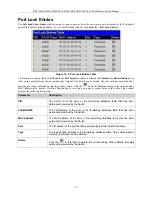
DES-3010F/DES-3010FL/DES-3010G/DES-3018/DES-3026 Fast Ethernet Switch Manual
Section 9
CPU Interface Filtering
Due to needed extra switch security, the DES-3018 switch incorporates CPU Interface filtering. This added feature
increases the running security of the Switch by enabling the user to create a list of access rules for packets destined for the
Switch’s CPU interface. CPU interface filtering examines Ethernet, IP and Packet Content Mask packet headers destined
for the CPU and will either forward them or filter them, based on the user’s implementation. As an added feature for the
CPU Filtering, the DES-3018 switch allows the CPU filtering mechanism to be enabled or disabled globally, permitting the
user to create various lists of rules without immediately enabling them.
Creating an access profile for the CPU is divided into two basic parts. The first is to specify which part or parts of a frame
the Switch will examine, such as the MAC source address or the IP destination address. The second part is entering the
criteria the Switch will use to determine what to do with the frame. The entire process is described below.
CPU Interface Filtering State Settings
In the following window, the user may globally enable or disable the CPU Interface Filtering mechanism by using the pull-
down menu to change the running state. To access this window, click
CPU Interface Filtering > CPU Interface Filtering
State
. Choose
Enabled
to enable CPU packets to be scrutinized by the Switch and
Disabled
to disallow this scrutiny.
Figure 9- 1. CPU Interface Filtering State Settings window
CPU Interface Filtering Table
The
CPU Interface Filtering Table
displays the CPU Access Profile Table entries created on the Switch. To view the
configurations for an entry, click the hyperlinked
Profile ID
number.
Figure 9- 2. CPU Interface Filtering Table
To add an entry to the
CPU Interface Filtering Table
, click the
Add
button. This will open the
CPU Interface Filtering
Configuration
page, as shown below. There are four
Access Profile Configuration
pages; one for
Ethernet
(or MAC
address-based) profile configuration, one for
IP
address-based profile configuration and one for the
Packet Content
Mask
. You can switch between the four
Access Profile Configuration
pages by using the
Type
drop-down menu. The
page shown below is the
Ethernet CPU Interface Filtering Configuration
page.
103






























